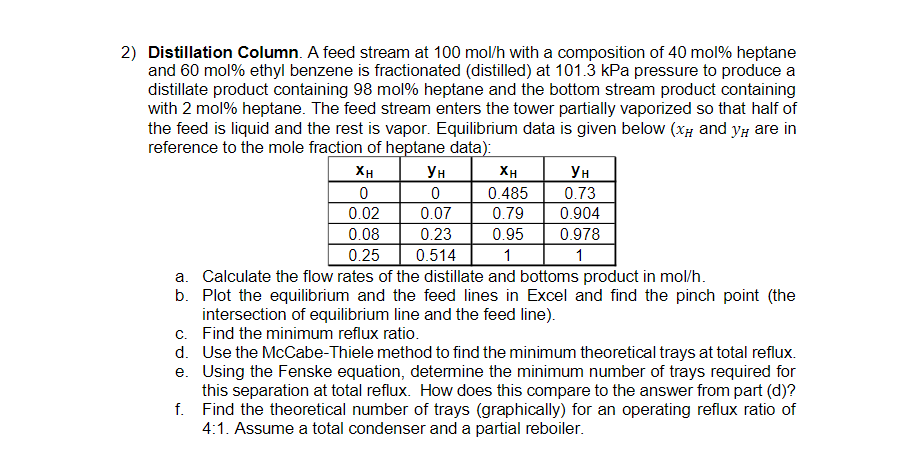2) Distillation Column. A feed stream at 100 mol/h with a composition of 40 mol% heptane and 60 mol% ethyl benzene is fractionated (distilled) at 101.3 kPa pressure to produce a distillate product containing 98 mol% heptane and the bottom stream product containing with 2 mol% heptane. The feed stream enters the tower partially vaporized so that half of the feed is liquid and the rest is vapor. Equilibrium data is given below (XH and yн are in reference to the mole fraction of heptane data): ΧΗ Ун ΧΗ Ун 0 0 0.485 0.73 0.02 0.07 0.79 0.904 0.08 0.23 0.95 0.978 0.25 0.514 1 1 a. Calculate the flow rates of the distillate and bottoms product in mol/h. b. Plot the equilibrium and the feed lines in Excel and find the pinch point (the intersection of equilibrium line and the feed line). c. Find the minimum reflux ratio. d. Use the McCabe-Thiele method to find the minimum theoretical trays at total reflux. e. Using the Fenske equation, determine the minimum number of trays required for this separation at total reflux. How does this compare to the answer from part (d)? f. Find the theoretical number of trays (graphically) for an operating reflux ratio of 4:1. Assume a total condenser and a partial reboiler.
2) Distillation Column. A feed stream at 100 mol/h with a composition of 40 mol% heptane and 60 mol% ethyl benzene is fractionated (distilled) at 101.3 kPa pressure to produce a distillate product containing 98 mol% heptane and the bottom stream product containing with 2 mol% heptane. The feed stream enters the tower partially vaporized so that half of the feed is liquid and the rest is vapor. Equilibrium data is given below (XH and yн are in reference to the mole fraction of heptane data): ΧΗ Ун ΧΗ Ун 0 0 0.485 0.73 0.02 0.07 0.79 0.904 0.08 0.23 0.95 0.978 0.25 0.514 1 1 a. Calculate the flow rates of the distillate and bottoms product in mol/h. b. Plot the equilibrium and the feed lines in Excel and find the pinch point (the intersection of equilibrium line and the feed line). c. Find the minimum reflux ratio. d. Use the McCabe-Thiele method to find the minimum theoretical trays at total reflux. e. Using the Fenske equation, determine the minimum number of trays required for this separation at total reflux. How does this compare to the answer from part (d)? f. Find the theoretical number of trays (graphically) for an operating reflux ratio of 4:1. Assume a total condenser and a partial reboiler.
Introduction to Chemical Engineering Thermodynamics
8th Edition
ISBN:9781259696527
Author:J.M. Smith Termodinamica en ingenieria quimica, Hendrick C Van Ness, Michael Abbott, Mark Swihart
Publisher:J.M. Smith Termodinamica en ingenieria quimica, Hendrick C Van Ness, Michael Abbott, Mark Swihart
Chapter1: Introduction
Section: Chapter Questions
Problem 1.1P
Related questions
Question
solve in 5-10 hours

Transcribed Image Text:2) Distillation Column. A feed stream at 100 mol/h with a composition of 40 mol% heptane
and 60 mol% ethyl benzene is fractionated (distilled) at 101.3 kPa pressure to produce a
distillate product containing 98 mol% heptane and the bottom stream product containing
with 2 mol% heptane. The feed stream enters the tower partially vaporized so that half of
the feed is liquid and the rest is vapor. Equilibrium data is given below (XH and yн are in
reference to the mole fraction of heptane data):
ΧΗ
Ун
ΧΗ
Ун
0
0
0.485
0.73
0.02
0.07
0.79
0.904
0.08
0.23
0.95
0.978
0.25
0.514
1
1
a. Calculate the flow rates of the distillate and bottoms product in mol/h.
b. Plot the equilibrium and the feed lines in Excel and find the pinch point (the
intersection of equilibrium line and the feed line).
c. Find the minimum reflux ratio.
d. Use the McCabe-Thiele method to find the minimum theoretical trays at total reflux.
e. Using the Fenske equation, determine the minimum number of trays required for
this separation at total reflux. How does this compare to the answer from part (d)?
f. Find the theoretical number of trays (graphically) for an operating reflux ratio of
4:1. Assume a total condenser and a partial reboiler.
Expert Solution
This question has been solved!
Explore an expertly crafted, step-by-step solution for a thorough understanding of key concepts.
Step by step
Solved in 2 steps with 7 images

Recommended textbooks for you

Introduction to Chemical Engineering Thermodynami…
Chemical Engineering
ISBN:
9781259696527
Author:
J.M. Smith Termodinamica en ingenieria quimica, Hendrick C Van Ness, Michael Abbott, Mark Swihart
Publisher:
McGraw-Hill Education

Elementary Principles of Chemical Processes, Bind…
Chemical Engineering
ISBN:
9781118431221
Author:
Richard M. Felder, Ronald W. Rousseau, Lisa G. Bullard
Publisher:
WILEY

Elements of Chemical Reaction Engineering (5th Ed…
Chemical Engineering
ISBN:
9780133887518
Author:
H. Scott Fogler
Publisher:
Prentice Hall

Introduction to Chemical Engineering Thermodynami…
Chemical Engineering
ISBN:
9781259696527
Author:
J.M. Smith Termodinamica en ingenieria quimica, Hendrick C Van Ness, Michael Abbott, Mark Swihart
Publisher:
McGraw-Hill Education

Elementary Principles of Chemical Processes, Bind…
Chemical Engineering
ISBN:
9781118431221
Author:
Richard M. Felder, Ronald W. Rousseau, Lisa G. Bullard
Publisher:
WILEY

Elements of Chemical Reaction Engineering (5th Ed…
Chemical Engineering
ISBN:
9780133887518
Author:
H. Scott Fogler
Publisher:
Prentice Hall


Industrial Plastics: Theory and Applications
Chemical Engineering
ISBN:
9781285061238
Author:
Lokensgard, Erik
Publisher:
Delmar Cengage Learning

Unit Operations of Chemical Engineering
Chemical Engineering
ISBN:
9780072848236
Author:
Warren McCabe, Julian C. Smith, Peter Harriott
Publisher:
McGraw-Hill Companies, The